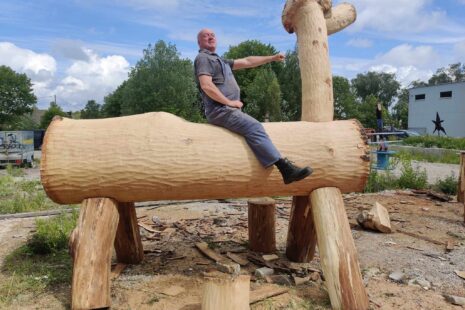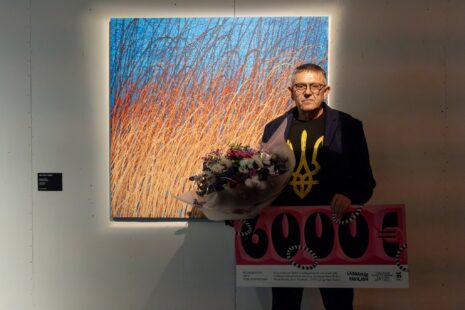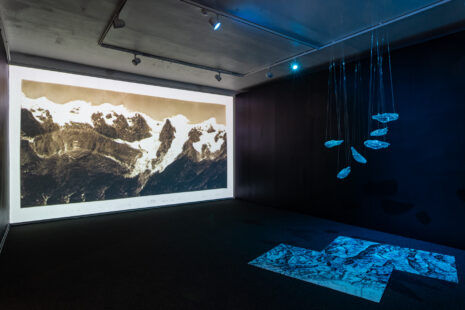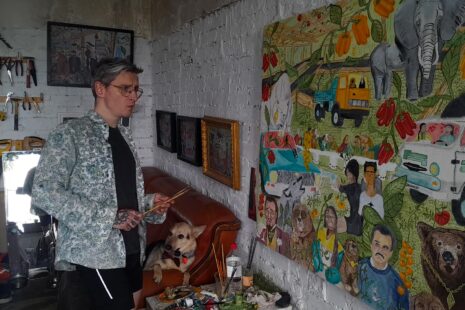Titled, “Together as to gather” the curators have utilized a ‘gathering methodology’ to define the biennial format while considering how to relate the event to the landscape and heritage of Norway. From this, members of the collective have individually ‘curated’ artists and the outcome provide viewers with a richly diverse, but rather disconnected constellation of works. In parallel, Tenthaus is also working actively with the public programming inviting additional artists, institutions, and other collectives to realize multiple performance, workshops and even a radio talk show throughout the months ahead. With these various layers “Together as to gather” consists of nearly 90 participants.
Amongst the various artworks and installations spread throughout the gallery’s premises, Estonian artist Jaanus Samma (b. 1982) has been invited to participate in the biennial by Tenthaus member Matilde Balatti who met Samma during a research trip with the collective in 2021. Balatti described being interested in how Samma’s practice incorporates aspects of cultural heritage, revealing how it can evolve and contribute to contemporary perceptions of identity.
Jaanus Samma’s works comprise the newly commissioned installation titled “National Utopia” and is inspired by the Norwegian traditional folk costume known as the bunad. Samma presents sets of clothing that offer a unique twist on the traditional — harnesses and jockstraps — which are fetish garments associated with queer culture.
The installation offers multiple layers of social commentary connecting to culture, nationalism, politics and the global economy.
The objects are elegantly made and include embroidery or beadwork and the patterns depart from original Norwegian patterns. During the preparations for the biennial, Samma learned that Norwegian bunads are hand-made in Estonian workshops, and in turn, each object for “National Utopia” has been hand-made by Estonian artisans. Samma’s practice is often research-based and departs from specific moments in history. He utilizes archives, documents and interviews, but expands his approach to include playful, subjective and intuitive interpretations. There are also certain themes and symbols that he repeatedly works within his projects, such as his use of men’s underwear, which he also incorporated into the 2021 exhibition “Patterns” at Monumental Gallery, Tartu. For Samma, a concept doesn’t need to end with an exhibition. Thus, in connection to his choice to work again with men’s underwear for “National Utopia”, he explains how he contemplated what a utopian history could include as it is a narrative that encourages all kinds of possibilities for expression.
Throughout history, many communities have been excluded or not welcomed to document and preserve their own experiences. Traditional folk costumes, such as the Norwegian bunad, also exemplify how history and traditions have been exclusionary. Bunads are numerous and unique to different regions of Norway, yet the patterns have been canonized through norms and there are strict limitations for altering them. As a result, the designs on the bunad exclude many identities. However, new bunad patterns are being introduced to represent the diversity that exists in Norwegian culture and communities; LGBTQ persons and Norwegians with other religions and ancestries are contributing to this. At the same time, Samma reveals he is fascinated by the ways in which history is so “telling”. In parallel to his work for Momentum 12, Samma is currently researching the Estonian tradition of wedding carpets and explains how “there is so much history and narrative woven into these carpets from the past; you have to be creative to interpret these past lives.”
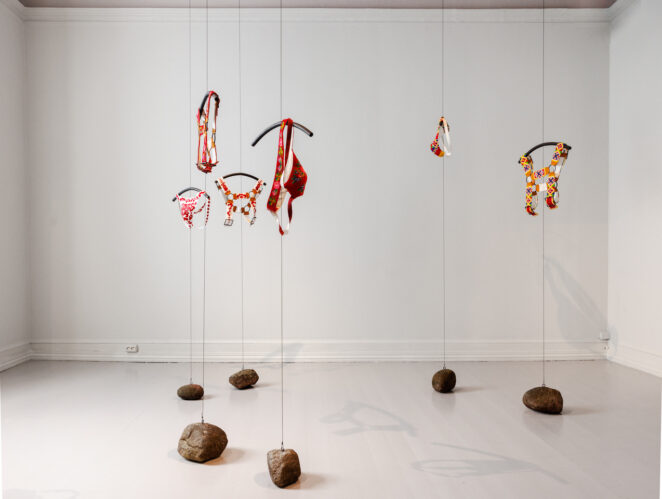
Photo: Eivind Lauritzen, Galleri F 15-4
Craft and handwork are consistent elements running throughout Samma’s artistic practice and several craftspeople were involved in the making of “National Utopia”. From sewing and beading to metalsmithing, these diverse knowledges are skills that he appreciates. Samma’s work with “National Utopia” highlights an underlying issue emerging as a result of our globalized and technologically engaged lives; the fact that Norwegian bunads are now made in Estonia suggests not only an economic maneuver, but most importantly how this incredible knowledge is diminishing in our contemporary world. While the unique traditions of folk costumes have been preserved through time and are important for representing national identities, Samma argues that if traditions, such as the bunads, are not allowed to change, then they will eventually die out. During his research for “National Utopia” Samma was in close contact with the Norwegian Institute for Bunad and Folk Costumes, and new interpretations have recently been welcomed as the institution recognizes the importance of developing new traditions in order to exist into the future.
In his artistic practice, Samma aims to expand historical narratives to support and highlight new voices and perspectives.
Reflecting on Estonia, Samma describes how Estonian history has also been defined by limited documentation and exclusionary principles and it is important to him to create awareness so other people can benefit. Like Norway, folk costumes are also an important part of Estonian culture, however in Samma’s opinion, conservative politicians have monopolized Estonian heritage and currently determine what it means to be Estonian. While “National Utopia,” unites two different countries, Samma eliminates the constraining norms of history and initiates a celebration of cultural traditions to promote a contemporary society where everyone has the opportunity to express their own unique pattern.
Anne Klontz is a curator based in Stockholm, Sweden.


